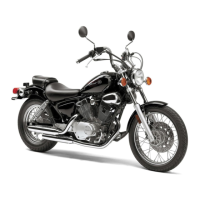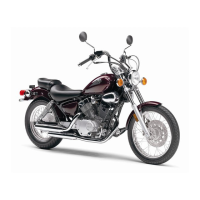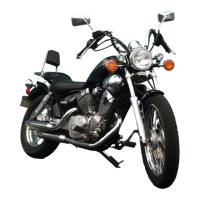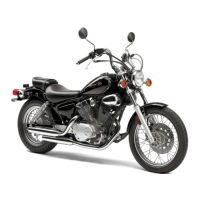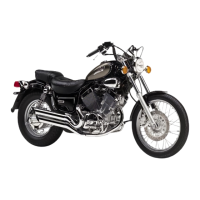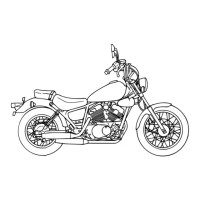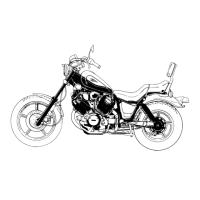Do you have a question about the Yamaha VIRAGO XV250V and is the answer not in the manual?
Always make pre-operation checks. Careful checks may help prevent an accident.
Wear protective clothing like helmets, jackets, boots, and gloves for safety.
Unauthorized modifications can render the motorcycle unsafe and illegal.
Adding accessories or cargo affects stability; use caution and distribute weight evenly.
Do not exceed maximum load limit. Distribute weight evenly for stability.
Use genuine Yamaha accessories; non-approved parts may affect safety and handling.
Handle gasoline safely, avoid spills, and operate in well-ventilated areas due to poisonous exhaust fumes.
Read and understand important labels on the vehicle before operating it.
Details cold tire normal pressure for different load conditions and California emission/vacuum hose routing.
Identifies key components and their locations on the left side of the motorcycle.
Identifies key components and their locations on the right side of the motorcycle.
Details the location and function of various controls and instruments on the handlebars.
Explains the function of the main switch and its positions (ON, OFF, P).
Describes the high beam, neutral, and turn signal indicator lights.
Details the odometer, tripmeter, and speedometer functions.
Explains left and right handlebar switch functions (lights, turn signals, horn, engine stop, start).
Controls high and low beams for the headlight.
Operates the turn signal lights for turns and cancellation.
Activates the horn to sound an audible warning.
Stops the engine in emergencies or when not in use.
Cranks the engine using the electric starter.
Engages and disengages the clutch for smooth gear changes.
Used in conjunction with the clutch lever to shift gears in the 5-speed transmission.
Operates the front brake by pulling the lever.
Operates the rear brake by pressing down on the pedal.
Details the operation of the fuel tank cap, including locking and unlocking.
Information on checking fuel level and refueling safely.
Explains the function and lever positions (ON, RES, PRI) of the fuel cock.
Controls the choke for a richer mixture when starting a cold engine.
Instructions for locking and unlocking the steering to prevent theft.
Details how to remove and install the rider seat for access.
Describes how to use the helmet holder lock.
Explains how to adjust the spring preload for suspension tuning.
Instructions for using the sidestand and its role in the ignition circuit cut-off system.
Explains the functions of the ignition circuit cut-off system for safe starting and operation.
Lists items to check before riding, including fuel, oil, brakes, clutch, and cables.
Step-by-step guide to starting and warming up the engine before riding.
Procedure for starting a warm engine, noting starter (choke) is not required.
Explains how to shift gears using the shift pedal and clutch lever.
Details the process of starting from a stop and accelerating.
Explains how to slow down and stop the motorcycle.
Crucial period for engine wear and polishing to establish correct clearances.
Instructions on how to safely park the motorcycle, including engine off and key removal.
Location and purpose of the owner's tool kit for maintenance.
Details required maintenance for emission control systems based on mileage and time.
Outlines general maintenance tasks and lubrication schedules for various components.
Instructions for removing and reinstalling the side panel for maintenance access.
How to check spark plugs for condition and potential engine issues.
Procedures for checking and cleaning the canister for fuel vapor emission control.
How to check engine oil level and information on oil/filter changes.
Step-by-step guide to cleaning the air filter element for optimal engine performance.
Carburetor adjustments are complex and should be left to a Yamaha dealer.
How to check and adjust the throttle cable free play for smooth operation.
Valve clearance changes affect air-fuel mixture and engine noise; requires dealer adjustment.
Points regarding tire pressure, tread depth, and condition for optimal safety.
Details approved tire sizes, manufacturers, and models for the motorcycle.
Checks for spoke wheels, including rims, spokes, and balancing.
Guidelines for choosing and installing accessories and replacement parts.
How to adjust the clutch lever free play for optimal clutch engagement.
How to adjust the brake lever free play for correct brake operation.
Instructions for adjusting the brake pedal position and its free play.
How to adjust the rear brake light switch for proper activation.
How to check brake pad and shoe wear for safe braking performance.
How to check the front brake fluid level and safety precautions.
Procedures for changing brake fluid and replacing seals/hoses.
How to check and adjust the drive chain slack for proper operation.
Instructions for cleaning and lubricating the drive chain to prevent wear.
Checking and lubricating control cables for smooth operation.
Checking and lubricating the throttle grip and cable for smooth throttle response.
How to check and lubricate brake and shift pedal pivots.
How to check and lubricate brake and clutch lever pivots.
How to check and lubricate the sidestand pivot and contact surfaces.
Lubrication of swingarm pivots at specified intervals.
How to check the front fork's condition and operation for safety.
How to check for worn or loose steering bearings.
How to check front and rear wheel bearings for play or smooth rotation.
How to check battery electrolyte level, connections, and general maintenance.
Instructions for replacing main and signaling system fuses.
Step-by-step guide to replacing the headlight bulb.
How to replace the tail and brake light bulbs.
Instructions for replacing the turn signal light bulbs.
Precautions for safely supporting the motorcycle during maintenance.
Steps for safely removing the front wheel for inspection or service.
Steps for safely removing the rear wheel for inspection or service.
A chart to diagnose and resolve common engine starting and operational issues.
General advice on keeping the motorcycle clean and protected from rust and corrosion.
How to clean the motorcycle after normal use, including rinsing and drying.
Special cleaning steps required after riding in rain or near saltwater to prevent corrosion.
Guidelines for storing the motorcycle short-term and long-term to prevent damage.
Provides overall dimensions, seat height, wheelbase, and ground clearance.
Lists the dry and wet weights for the motorcycle models.
Details engine type, displacement, bore, stroke, compression, and lubrication.
Information on the carburetor manufacturer, type, and quantity.
Specifies manufacturer, model, and gap for spark plugs.
Details the clutch type.
Provides primary/secondary reduction ratios and gear ratios.
Lists voltage, wattage, and quantity for all bulbs on the motorcycle.
Specifies the amperage ratings for the main and signaling system fuses.
Instructions to record key, VIN, and model label information for parts ordering and theft reference.
Location and importance of the model label for ordering parts.
How to report safety defects to NHTSA and Yamaha.
Federal law prohibits tampering with noise control systems.
A chart to record maintenance dates, mileage, and servicing dealer.
Details the limited warranty terms, exclusions, and customer responsibilities.
Answers common questions regarding the motorcycle warranty.
Provides contact information for Yamaha Motor Corporation U.S.A. for service issues.
Information about Yamaha Extended Service plans for ongoing protection.
| Displacement | 249 cc |
|---|---|
| Bore x Stroke | 49.0 x 66.0 mm |
| Fuel System | Carburetor |
| Transmission | 5-speed |
| Final Drive | Chain |
| Front Suspension | Telescopic fork |
| Front Brake | Single disc |
| Rear Brake | Drum |
| Front Tire | 3.00-18 |
| Ground Clearance | 150 mm |
| Engine Type | Air-cooled, 4-stroke, V-twin, SOHC |
| Compression Ratio | 10.0:1 |
| Power | 21 hp (15.4 kW) @ 8, 000 rpm |
| Carburetor Type | Mikuni BDS26 |
| Ignition | Transistorized |
| Rear Suspension | Swingarm |
| Fuel Capacity | 9.5 liters |


